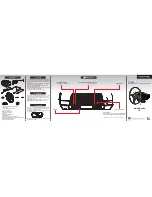
Starting up the device
Leuze electronic
ODS 9
33
7
Starting up the device
7.1
Teaching and configuring output functions
7.1.1
Setting the analog output
The sensors are equipped with an analog output with linear response within the respective measurement
range.
Above and below the measurement range linearity is not obtained. If a signal is present, the output values
can be used to determine whether the measurement range is exceeded or not met.
In order to achieve the highest resolution possible, set the range of the analog output as small as the appli-
cation allows. The characteristic output curve can be configured as rising or falling, e.g. for fill level applica-
tions.
The output can be switched to current or voltage with the following ranges:
• 4 … 20 mA
• 1 … 10 V
• 0 … 10 V
To configure the analog output, the two distance values
Position Min. Val.
and
Position Max. Val.
are speci-
fied at which the respective minimum or maximum analog value is output.
Measurement range
C
is assigned ex works (see figure), e.g., 50 … 100 mm for device types
-100
.
A
Area not defined
B
Linearity not defined
C
Measurement range
D
Object present
E
No object detected (characteristic curve behavior configurable via IO-Link)
F
Measurement distance
Fig. 7.1:
Characteristic curve of analog output ODS9L2.8/LA…-M12
Setting the analog output
You can set the characteristic output curve for the analog output as follows:
• Directly changing the parameters:
• On the device via the OLED display and the control buttons (see chapter 3.4 "Configuration / menu
• Via the
Sensor Studio
configuration software (see chapter 8 "Connecting to a PC – Sensor Studio").
• Teach-in / teach:
• Via IO-Link (see chapter 7.1.5 "Teaching the output functions via the IO-Link system commands"),
especially using the
Sensor Studio
configuration software (see chapter 8 "Connecting to a PC –
• Via the multifunction input with set
Teach
















































